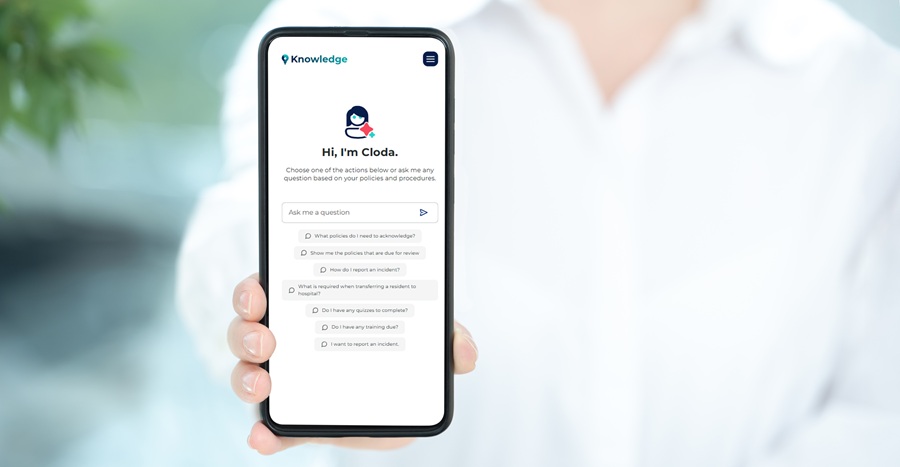
Introduction: Why User Adoption is the Real Battleground for Digital Transformation
In social care and healthcare, the introduction of digital solutions promises streamlined compliance, improved patient safety, and more effective service delivery. Yet, beneath the surface of every new system rollout lies a familiar, stubborn challenge: user adoption. No matter how advanced or feature-rich a solution may be, its value is realised only when staff embrace it and integrate it into their daily routines.
For many organisations, the pain point isn’t the technology itself, it’s ensuring that people actually use it. Resistance, confusion, and disengagement can quickly undermine even the best-laid digital strategies.
This article explores proven strategies to overcome adoption hurdles, drawing on real-world results and lessons learned from organisations that have successfully embedded Cloda into their organisation.
Before we dive in, we would love to hear your thoughts below!
Poll: What is the biggest challenge your organisation faces in getting staff to adopt new digital systems?
Cast your vote and see what your peers say!
Understanding the Pain Points of User Adoption
The High Stakes of Low Adoption
The consequences of poor user adoption are significant. When staff don’t engage with new digital solutions:
- Policies and procedures go unread or unacknowledged.
- Compliance risks increase, putting the organisation’s reputation and service quality on the line.
- Investments in technology yield little return, and staff revert to outdated, inefficient practices.
Common Barriers to Adoption
- Resistance to Change: Staff may be comfortable with existing routines or wary of new systems.
- Time Pressures: In fast-paced care environments, learning a new tool can feel like “one more thing” on an already full plate.
- Complexity and Usability: If a system is not intuitive, staff quickly become frustrated or disengaged.
- Lack of Visibility: Without real-time feedback, managers can’t see who has engaged or where support is needed.
- Information Overload: Too many updates, policies, or training materials can overwhelm even the most dedicated teams.
A Case Study in Overcoming Adoption Barriers – Introducing Cloda
To illustrate how these challenges can be addressed, let’s look at the experience of a social care service provider that implemented Cloda.
The Starting Point
Before Cloda, the organisation faced:
- Fragmented access to current policies and procedures.
- Time consuming searches through policies to find key information.
- Managers lacking insights into staff understanding and participation.
These issues led to delays in decision making, uncertainty, and missed opportunities for learning and improvement.
Strategies That Drive User Adoption
Drawing on this real-world example, here are the strategies that we implemented during the introducing of Cloda that made the difference to user adoption of the system.
1. Prioritising User-Friendly Design
Strategy: The organisation required a solution that was simple, easy to use and mobile-enabled to allow staff instant access to procedures. Cloda was further enhanced with the introduction of a new Just Ask Cloda landing page which encouraged staff to ask Cloda a question on procedures via the chat functionality or the use of a prompt.
Why it worked: After the introduction of the new Cloda landing page, the number of weekly active users asking Cloda queries grew to 91%. This demonstrated that the Cloda landing page increased value for staff leading to a 60% chance of returning to the system.
2. Frictionless Access
Strategy: The systems mobile capabilities and user friendliness meant it was easy to access the system. The simple user guide and video tutorials supported staff to add the shortcut to the Cloda app to their mobile or desktop home screen with ease.
Why it Worked: These measures meant that staff always had easy access to the Cloda app. As a result, user adoption of the system is at 83%.
3. Multimedia Onboarding and Ongoing Support
Strategy: To support users in adapting to the change and to avoid information overload, a combination of onsite training and short video tutorials were used. Having resources available on-demand, allowed staff to learn about the system at their own pace.
Why it Worked: Different learning styles were accommodated. The in-person training allows staff face-to-face interaction to ask queries, whilst the video tutorials empowered to explore the system at a time that suited them.
4. Consistent, Positive Communication
Strategy: A weekly communications plan was developed to remind staff of Cloda, share tips, user experiences and gather feedback. These communications included videos from Cloda encouraging staff to use the system. The client is also a mobile-first organisation with 73% of Cloda users coming from mobile. Consequently, WhatsApp videos were also used to encourage staff to login to Cloda.
Why it Worked: Regular touchpoints kept Cloda top-of-mind and built a sense of community and shared purpose.
5. Incentivising Engagement
Strategy: Staff were entered into a weekly draw every time they asked Cloda a question. This encouraged staff to try out Cloda and see how she could support them in their practice.
Why it Worked: It was identified that staff who asked Cloda a question had a 59% chance of returning to the system. By using incentives to nudge staff to ask a question, it allowed to staff to see the value of Cloda, whilst also making the adoption process fun and rewarding.
6. Data-Driven Feedback Loops
Strategy: Weekly project team meetings were introduced to review Cloda’s analytics to monitor user adoption in real time. Data was shared with managers around the common types of questions asked in Cloda and what the most popular policies being cited were.
Why it Worked: This real-time feedback kept management informed during the implementation process, shared encouraging data with them and provided them with valuable insights as to where knowledge gaps may lie within the service.
7. Engaged Project Team
Strategy: Dedicated resources were put in place on the client’s side to support the onboarding process. This team ensured that communications were distributed in a timely manner and facilitated follow up with staff when necessary.
Why it Worked: Having an engaged project team helped to get buy in from staff and ensured there was consistent communication throughout the roll-out.
The Results – What Effective Adoption Looks Like
After six weeks, the social care provider saw remarkable results:
- User Adoption: 83% of staff logged into Cloda and used the system.
- Active Engagement: 64% of staff asked Cloda at least one question.
- Landing Page Engagement: 91% of active users asked Cloda a question following the introduction of the landing page.
- Conversational Use: 60% of active users had a conversation with Cloda (more than one question in a session).
- Return Rate: 59% chance of returning to the system if the user asked Cloda a question.
Lessons Learned – Best Practices for Driving User Adoption
The journey of this social care service provider demonstrates that meaningful user adoption of digital solutions like Cloda is achievable when thoughtful strategies are put in place. Here is the core lessons learned from their experience – insights that can guide any organisation seeking to embed new technology into daily practice:
User Experience is Everything
A user-friendly, intuitive interface isn’t a luxury, it’s essential. By prioritising simplicity, mobile access, and an intuitively designed landing page, you can remove initial barriers and make solutions like Cloda a natural part of the workday. When staff feel confident using a system without frustration or confusion, engagement follows.
Remove Barriers to Access
Frictionless access is a major driver of adoption. In addition to easy-to-follow user guides and mobile capabilities, implementing Single Sign On and providing shortcuts can help staff reach your new system with minimal effort. The easier it is to access the platform, the more likely staff are to use it regularly and at the point of need.
Support All Learning Styles
Recognising that staff have diverse learning preferences, organisations should offer a blend of onsite training and on-demand video tutorials. This dual approach allows staff to get comfortable with a new system at their own pace, whether through face-to-face guidance or self-directed learning.
In-App Tour
In-App tours are a great way to guide new users through how to use a system. This feature has recently been introduced for Cloda and will run for new users as they log in to the system.
Make Communication Consistent and Positive
Sustained, positive communication kept Cloda top-of-mind and foster a sense of shared purpose. Weekly updates, practical tips, and real user stories help reinforce the system’s value and encourage ongoing engagement. Leveraging multiple channels, including WhatsApp and video messages, ensures communications reach everyone.
Incentivise Early and Ongoing Engagement
Small incentives helped nudge staff to try Cloda. Once they experience the benefits firsthand, many returned on their own. Incentives can be a powerful catalyst for initial adoption, especially when paired with a fun, supportive culture.
Use Data to Inform and Inspire
Real-time analytics provide critical feedback to both project teams and managers. Sharing usage data and popular queries not only highlights successes but also reveals knowledge gaps and areas for further support. Data-driven insights enable targeted interventions and celebrated progress, reinforcing positive behaviours.
Leadership and Team Buy-In are Critical
Throughout the process, visible support from leadership, involvement of managers and having a dedicated project team is key. Regular project meetings, data sharing and weekly communications, ensures that everyone from frontline staff to senior management, remain aligned and motivated.
The Bigger Picture — Why Adoption Matters
When staff adopt digital solutions like Cloda, the benefits go far beyond compliance:
- Policies and procedures become living resources, not static documents.
- Staff are more confident, informed, and equipped to deliver safe, effective care.
- Organisations see better audit outcomes, reduced risk, and a stronger return on technology investments.
Conclusion: Empower Your Team — Don’t Leave Adoption to Chance
User adoption is the linchpin of digital transformation in healthcare and social care. By addressing pain points head-on and employing strategic, people-focused approaches, organisations can turn new digital solutions into everyday assets.
Ready to see how Cloda can drive engagement and compliance in your service? Contact info@knowledge.care or call 01 629 2559.

Book a Demo (1)
"*" indicates required fields
